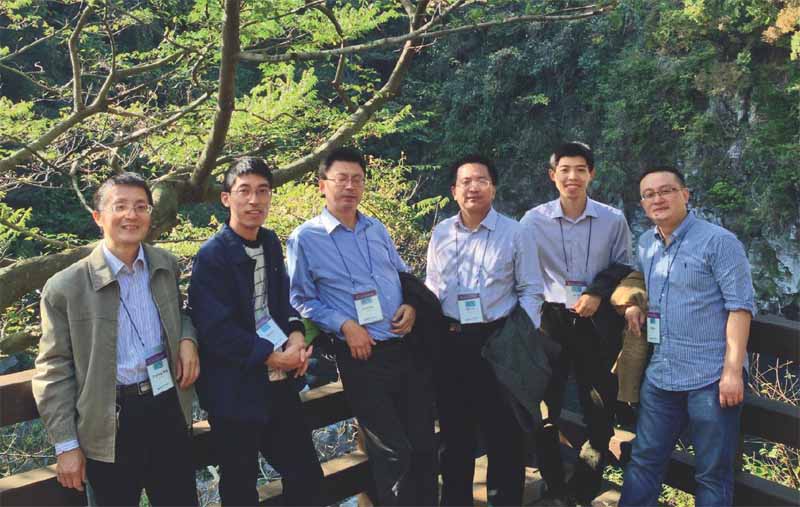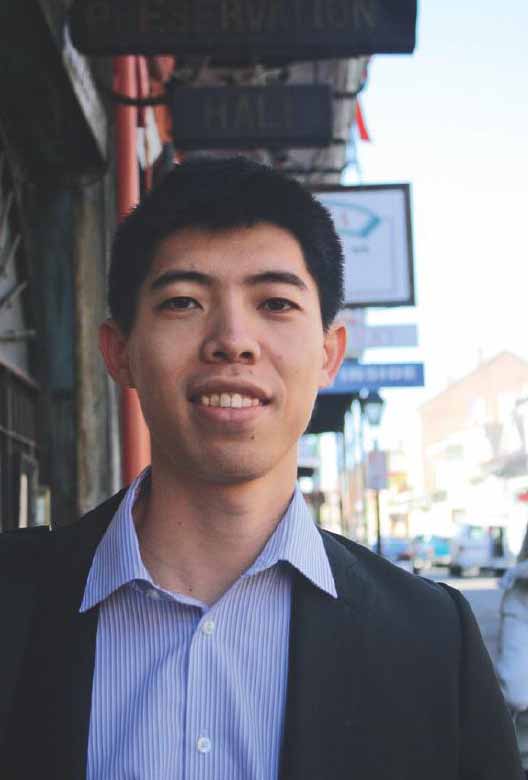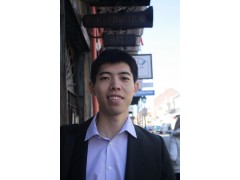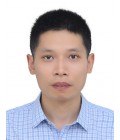专家信息:

林智,男,1980年11月30日出生,浙江大学应用数学研究所副所长,博士生导师。
教育及工作经历:
1998--2002,华南理工大学, 应用数学系, 理学学士, 导师:郝志峰。
2002--2007,University of North Carolina (USA),数学系,博士,导师:R. McLaughlin / R. Camassa。
2007--2009,University of Michigan (USA), 数学系, 助理教授。
2009--2011,Institute of Mathematics and its Applications (USA), 研究员 。
2011至今, 浙江大学数学系,特聘研究员。
Professional Membership:
American Mathematical Society, Society for Industrial and Applied Mathematics,American Physical Society.
主讲课程:
浙江大学 (Zhejiang University, Hangzhou, China):
《计算方法》 (Methods of Scientific Computation) (Spring/Summer '11-'14; Fall/Winter '15-'16)
研究生公选课程:《数值计算方法》 (Methods of Scientific Computation) (Fall '13-'15)
《常微分方程》 (Ordinary Differential Equations) (Fall '12-'15; Summer '13-'15)
《偏微分方程》 (Partial Differential Equations) (Winter '12-'15)
《博士生专业英语/LaTeX入门》 (Introduction to LaTeX) (Spring '14-'15)
U. of Michigan at Ann Arbor:
Spring 2009, Math 450: Advanced Mathematics for Engineers I Sample syllabus
Fall 2007 - Fall 2008, Math 471: Introduction to Numerical Methods Sample syllabus (PDF)
U. of North Carolina at Chapel Hill:
Fall 2006, Math 231 (Old 31): Calculus I: Functions of One Variable
Fall 2003, Math 230 (Old 30): Precalculus: Trigonometry and Analytic Geometry
Tutored and Assisted Courses:
Math 521 (Old 121): Advanced Calculus I
Math 547 (Old 147): Linear Algebra for Applications
Math 661 (Old 191): Scientific Computation I
研究方向:
偏微分方程,流体力学,渐近方法
Research Support:
1. Institute for Mathematics and its Applications, Minneapolis, Minnesota, USA.Postdoctoral Associate August 2009-present.
“Optimal Mixing and Biogenic Mixing", Institute for Mathematics and its Ap-plications: Thematic Year on Complex Fluids and Complex uids, Supported by National Science Foundation.
2. University of Michigan, Ann Arbor, Michigan, USA.Postdoctoral Assistant Professor.August 2007-May 2009
“Mixing e ciency of turbulent ows", Department of Mathematics, Supported by NSF award \Studies in Mathematical Physics: Advection, Convection and Turbulent Transport" (PHY-0555324).
3. University of North Carolina, Chapel Hill, North Carolina, USA.Research Assistant.September 2004-July 2007
“Scale dependent, heavy-tailed distributions in geophysical ows: physical mech-anisms and data assimilation", Department of Mathematics, Supported by NSF award \Collaborations in Mathematical Geosciences" (ATM-0327906).
4. Research Assistant.January 2004-January 2005.
“Turbulent jets and plumes in a strati ed environment", UNC Fluids Lab, De-partment of Mathematics.
科研成果:
1. Passive Scalar Intermittency
The mixing and transport phenomena in various fluids are often characterized by the behavior of fluctuation fields of submerged physical observables, many of which can be modeled as passive scalars, such as temperature, moisture, and chemical concentrations. "Passive" means that they do not affect the underlying flow. These quantities not only are the subject matters in environmental control, combustion, and biochemical reactions but also serve as proxies for the study of turbulence.
Scalar intermittency refers to the non-Gaussian scalar statistics widely observed in laboratory and field experiments. These "intermittent" probability distributions usually possess heavy tails indicating "anomalously" high probabilities for large and rare fluctuations than a normal distribution would suggest. In other words, they are inconsistent with the general Gaussian assumptions used, on account of their mathematical simplicity, in operational meteorology and climatology and they may drastically change the estimates concerning the current and future states of the environment.
R. Camassa, ZL and R. M. McLaughlin, Evolution of the probability measure for the Majda model: new invariant measures and breathing PDFs, Journal of Statistical Physics, 130(2): 343--371 (2008).
J. Bronski, R. Camassa, ZL, R. M. McLaughlin and A. Scotti, An explicit family of probability measures for passive scalar diffusion in a random flow, Journal of Statistical Physics, 128(4): 927--968 (2007).
(Resources: '07 UMich Talk; '07 MSRI Talk Video)
2. Mixing Measures
When it comes to describing how well-mixed a body of fluid is with some dye in it, there's really no concensus on what measure to use. Scalar statistics is one such measure; traditionally the mean-squared displacement of scalar particles is also one. Spatial variances are yet another common class which measures the homogeneity: after all, they are what we preceive looking at these pictures. Depending on the physics involved, the most natural measure to use and consequently, the mathematical challenges, approaches can vary.
Using different measures for the same problem sometimes can lead to conflicting and confusing results, while at other times, they can be complementary to each other and put together a comprehensive picture of the science. With a particular choice of the mixing measure, it's also possible to derive flow-control strategies are to optimize the flow-enhanced scalar mixing and transport in industrial applications like microfluidics.
E. Lunasin, E., ZL, A. Novikov, A. Mazzucato and C. R. Doering, Optimal mixing and optimal stirring for fixed energy, fixed power or fixed palenstrophy flows, Journal of Mathematical Physics, 53(11): 115611 (2012).
ZL, J.-L. Thiffeault and C. R. Doering, Optimal stirring strategies for passive scalar mixing, Journal of Fluid Mechanics, 675: 465--476 (2011).
ZL, K. Bodova and C. R. Doering, Models and measures of mixing and effective diffusion, Discrete and Continuous Dynamical Systems - A, 28(1): 259--274 (2010).
R. Camassa, ZL and R. M. McLaughlin, The Exact Evolution of the Scalar Variance in Pipe and Channel Flow, Communications in Mathematical Sciences, 8(2): 601--626 (2010).
(Resources: SIAM DS09 Talk, '10 UMN Talk)
3. Biogenic Mixing
Vertical mixing and transport in the ocean have always been central research topics for oceanographers and even more so for marine biologists. These mechanisms, by controlling the upwelling and sinking of nutrients/toxics and living species, play a vital role in almost all biological and chemical processes and eventually in the genesis and evolution of life on earth, especially in periods of climate change.
While the winds and tides have been naturally considered to be among the obvious driving forces, but: Do fish stir the ocean? And other marine species like whales and shrimps and planktons? Apparently their terrestrial and amphibious relatives such as earthworms and crabs are known to shape the geometry and composition of their surroundings. For decades scientists have been arguing about the significance of biogenic mixing in the oceans only based on some rough, top-down/energy budget/scaling calculations.
ZL, J.-L. Thiffeault and S. Childress, Stirring by squirmers, Journal of Fluid Mechanics, 669: 167--177 (2011).
(Resources: '10 IMA Poster, '11 ICIAM Talk; Coverage 1, 2 and 3 feat. JLT and SC)
4. Underwater Turbulent Plumes and Jets
The recent Deepwater Horizon blowout in the Gulf of Mexico caused catastrophic damages to the local ecology and human society. This is one prominent example of how a better knowledge of underwater turbulent plumes and jets would have saved billions (of lives). One huge problem after the crisis was that the oil plumes got trapped and spreaded below the water surface which made the skimming impossible. Knowing when and how this happened will provide valuable insights in environmental loss estimation and prevention.
R. Camassa, ZL and R. M. McLaughlin, Internal trapping of plumes in stratified environments, in preparation.
(Resources: UNC Experiment on Youtube; Coverage 1 and 2 feat. RMM and RC)
5. Multiscale and Stochastic Simulations
6. Homogenization and Asymptotic Methods
7. Parallel Computing with GPUs
代表性论文:
1 Lunasin, E., Lin, Z., Novikov, A. and et. al., Optimal mixing and optimal stirring for fixed energy, fixed power or fixed palenstrophy flows, Journal of Mathematical Physics, 53(11), 2012.(Top, SCI)
2 Adalsteinsson, D., Camassa, R., Lin, Z. and et. al, Subsurface Trapping of Oil Plumes in Stratification: Laboratory Investigations, Geophysical Monograph Series, 195, 2011.
3 Lin, Z., Thiffeault, J.-L. and Doering, C. R., Optimal stirring strategies for passive scalar mixing, Journal of Fluid Mechanics, 675, 2011.(Top, SCI)
4 Lin, Z., Thiffeault, J.-L. and Childress, S., Stirring by squirmers, Journal of Fluid Mechanics, 669, 2011.(Top, SCI)
5 Lin, Z., Bodova, K. and Doering, C. R., Models and measures of mixing and effective diffusion, Discrete and Continuous Dynamics Systems - A, 28(1), 2010.(Top, SCI)
6 Camassa, R., Lin, Z. and McLaughlin, R. M., The exact evolution of the scalar variance in pipe and channel flow, Communications in Mathematical Sciences, 8(2), 2010.(SCI)
7 Camassa, R., Lin, Z. and McLaughlin, R. M., Evolution of the probabilitymeasure for the Majda model: new invariant measures and breathing PDFs, Journal of Statistical Physics, 130(2), 2008.(SCI)
8 Bronski, J. C., Camassa, R., Lin, Z. and et. al., An explicit family of probability measures for passive scalar diffusion in a random flow, Journal of Statistical Physics, 128(4), 2007.(SCI)
Invited Presentations:
1. “Mixing and Transport of Passive Scalar in Fluids", Institute of Natural Sciences,Presentations Shanghai Jiao Tong University, Shanghai, China.November 2011
2. “A Simple Model for Biogenic Mixing", Applied Math Seminar, Guangdong Uni-versity of Technology, Guangzhou, China.September 2011
3. “A Stochastic Hydrodynamic Model for Biogenic Mixing", International Confer-ence on Interdisciplinary, Applied and Computation Mathematics, Zhejiang Uni-versity, Hangzhou, China.June 2011
4. “Optimal Mixing", The 63rd Annual Meeting of Division of Fluid Dynamics,American Physical Society, Long Beach, CA.November 2010
5. “Calculus of Variations and its Applications in Mixing", Minnesota Undergraduate Math Club, University of Minnesota, Minneapolis, MN.March 2010
6. “Mathematical models and measures of mixing", IMA Postdoc Seminar, Min-neapolis, MN.November 2009
7. “Measures of mixing and e ective di usion", SIAM Conference on Applied Dy-namical Systems, Snowbird, UT.May 2009
8. “Passive scalar intermittency in random ows", Applied and Industrial Math Sem-inar, University of Michigan, Ann Arbor, MI.February 2008
9. “The Majda model and scalar intermittency in random ows", SIAM Conference on Applied Dynamical Systems, Snowbird, UT.June 2007
10.“ Simple models of passive scalar intermittency", Mathematical Issues in Stochastic Approaches for Multiscale Modeling, MSRI, Berkeley, CA.May 2007
11. “Passive scalar intermittency in random ows", Applied Mathematics Lab Semi-nar, Courant Institute, New York, NY.February 2007
12. “Non-Gaussianity in turbulent transport", Southeastern Atlantic Mathematical Sciences Workshop, College of Charleston, Charleston, SC.September 2006
13. “An explicit family of probability measures for passive scalar di usion in a random ow", AIMS' Sixth International Conference on Dynamical Systems, Di erential Equations and Applications, University of Poitiers, Poitiers, France. June 2006
14. “The spatio-temporal evolution of the probability density function for a passive scalar advected by a rapidly varying random wind", Southeastern Atlantic Mathe-matical Sciences Workshop, University of North Carolina, Chapel Hill, NC. Septem-ber 2005
15.(Poster) “A Hydrodynamic Model of Biogenic Mixing", IMA Workshop for Natural Locomotion in Fluids and on Surfaces: Swimming, Flying, and Sliding, University of Minnesota, Minneapolis, MN. June 2010
16.(Poster) “Full PDF reconstruction from exact statistical moments of the advection-di usion of a passive tracer in a random ow", SIAM Conference on Applied Dy-namical Systems, Snowbird, UT.May 2005
17.(Poster) “Plume mixing and entrainment in a strati ed environment", Southeast-ern Atlantic Mathematical Sciences Workshop, College of Charleston, Charleston, SC September. 2004
荣誉奖励:
1. Postdoctoral Summer Research Fellowship, University of Michigan 2008
2. Scholars for Tomorrow Fellowship, University of North Carolina 2002-2004
3. Dissertation Fellowship, South China University of Technology 2002
4. Meritorious, The Mathematical Contest in Modeling, COMAP 2001
5. Second Prize, Contemporary Undergraduate Mathematical Contest in Modeling,CSIAM 2000
6. Annual Collegiate Scholarship, South China University of Technology 1999 -2001
Meetings:
1. Organizer, Minisymposium on Mixing in Geophysics and Engineering, SIAM Conference on Applications of Dynamical Systems, Snowbird, UT May 22-26,2011.
2. Organizer, Minisymposium on Optimal Mixing, The 7th International Congress on Industrial and Applied Mathematics, Vancouver, BC, Canada July 18-22,2011.
Committees:
Chair, Fundraising Team, Chinese Scholars and Students Association, University of Michigan 2009
曾受到美国工业与应用数学协会(SIAM)、美国国家数学研究所(MSRI)、纯数学与应用数学研究所(IPAM)等组织资助和邀请在中国、美国、法国和加拿大等地作专题报告。
2011年5月与7月分别于SIAM动力系统双年会及四年一度的国际工业及应用数学大会(ICIAM 2011)各组织了一次有关混合输运的专题研讨会。

林智,浙江大学应用数学研究所副所长。主要从事流体力学问题驱动的应用数学和计算数学研究。发表Top、SCI收录论文8篇。曾获美国北卡罗莱纳大学“明日学者”奖学金, 2008年暑期获美国密歇根大学博士后研究资助项目。回国之后,已在短时间内和新成立的浙大海洋科学和工程系、国家海洋局第二海洋研究所的相关科研人员开展了稳定广泛的学术交流。
“数学是透视世间万象的工具”,用这句话来形容林智对数学的认识,既贴切又恰当。
作为一名科研人员,他有着对埋头实验室做科研的痴迷;作为一个社会人士,他又充满着对世间万物强烈的好奇。他试图用钟爱的数学理论去解构这个世界,把枯燥的论理与世间的繁芜融合起来,化复杂为简单。
他把数学中的偏微分方程、随机过程、渐近方法、变分法、数值模拟等数学理论和工具应用于海洋世界、城市污染防控及各项交叉学科当中,取得诸多原创性成果,得到国内外认可的同时,他并未停下科研的脚步,仍继续把“应用数学”这一学科的价值发挥到实处。
他就是浙江大学应用数学研究所副所长林智,一位青年导师。
从数学到流体力学
1998年,林智就来到华南理工大学应用数学系,从此叩开了数学世界的大门。2002年,他去美国北卡罗莱纳大学读博,一次机遇让他的科研轨迹开始转向。
“在美国攻读博士期间,由于二年级时进入了由Richard McLaughlin和Roberto Camassa两位教授主持的“应用数学及海洋科学联合流体力学实验室”担任助教,主要指导本科生进行实验研究和整理数据,自此对流场中的各种混合输运问题产生了浓厚的兴趣”。
于是,林智选择了McLaughlin和Camassa两位教授作为论文导师,并在美国自然科学基金会“数学与地球科学协作”(CMG)项目的资助下进行博士阶段的学习。从此,正式进入流体力学科研领域。
“万物皆数”——古希腊数学家毕达哥拉斯的这句话固然过于夸张,但林智始终相信,数学的魅力就在于它的抽象理论应用能够揭示各种现象和问题的本质,让人们发现这个世界的精彩。
林智在前人研究基础上,认为在流场中“混合输运建模分析能够帮助我们了解自身所处生存环境的变化规律,同时能够在实践工程中预测、防控这一类过程,而且在经典流体问题——比如刻划湍流和混沌的特征和形成机制的研究上,也是常用的数学手段”。
从2005年开始,林智就在利用类Sobolev多尺度测度和概率工具刻划混合输运、建立广义弥散—扩散模型、对混合输运作变化法优化控制等方面积极探索,取得到一些原创性成果。
流场中混合输运方面的系列研究,让林智建立了全面的数学建模思想体系。之后,他开始把眼光转向了更为真实、复杂的海洋世界。
解构海洋世界
海洋,辽阔而又深邃。自古以来,人类从未放弃对海洋世界的探索。从远古时期的鱼盐之利、舟楫之便,到航海时代的战略要塞、运输渠道,再到现代文明的深度利用、服务社会,海洋的应用价值被逐渐提升,蕴藏在海洋中的丰富资源被逐一发掘。
近年,随着海洋经济步伐的持续加快,海洋环境的保护之声日渐迭起。因此,更好地了解海洋环境、利用海洋中数量庞大的生物资源,就成为新时代海洋发展战略中的关键一环。
痴迷于流场中混合运输问题的林智认为,“微小生物个体的流动产生混合输运,已经成为多个学科领域专家所关心的问题”。在这种局面下,要与地球科学、生化医药和工程控制等交叉学科科研人员展开联合研究。
2010年起,林智就把数学建模思想应用在了海洋中生物资源模拟上。
他寻找到志同道合的人,共同建立了模拟生物体游动产生标量混合输运的首个随机流体力学模型。原创性地刻画了稀疏生物个体随机游动产生的统计力学问题,并导出了同时适用于势流场和Stokes流场的等效扩散系数公式。
在主持的国家自然科学基金青年基金项目“标量混合输运的统一测试分析、仿真及优化控制”时,面对复杂流下标量的混合输运的混合测试问题,基于混合输运问题的多尺度、多机制特性,他探索出一种能应用在各种尺度和物理图景、具有广适性的统一混合测度,并在此基础上建立数学模型和导出优化控制策略,揭示了混合输运现象的本质和规律,同时为标量混合的科学和工程实践提出了最大利益化模型。
通过直观地引入类Sobolev范数的多尺度混合测度,基于经典热扩散方程进行的广义偏微分方程建模,他得到了在混合程度上与精确解等价的等效标量分布……这一系列原创性成果,具备更好的广适性,在国内外引起强烈反响。
回国短短几年,林智就与浙江大学海洋科学和工程系、国家海洋局第二海洋研究所展开合作,建立了长久的合作关系,开展了稳定广泛的学术交流,为今后海洋流体问题的全方位研究,搭建了更加坚实的科研平台。
大数据下的城市建模
流体,不仅仅只局限于海洋。
随着城市化建设的脚步加快,各色污染物大量涌现,对空气、土壤产生了极大威胁,严重阻碍了各大城市的良性发展。
“我希望数学能够突破原有框架,为人类发展服务”。2014年,浙江大学与帝国理工大学成立“联合数据科学实验室”,这为从不拘泥于实验室做科研的林智带来了一个契机,他开始从反问题的角度,研究考察城市环境内各种污染物的生成、传播和控制问题。
纵观我国科研领域近几十年的发展,有关反问题的理论研究、数值计算和分析方法一直备受重视,例如在一些国家重大战略需求的科学领域和工业研究中(如工业、环境监测、医学诊断、设备安检、地质勘探等)均广泛应用。尤其是以数学为中心,聚集了大量物理、化学、材料、医学、环境、计算机等多学科、多领域的科学家,早已开展了深入的交叉合作。
基于此,他积极参与了两项国家自然科学基金项目——“应用反问题的建模与计算”和“反问题的数学建模、计算及应用”。项目结合英方的高性能数值算法和浙大数学系团队的反问题方面的建模成果,展开了研究。一方面,通过对正问题的研究评价和预测污染物的影响;另一方面,能过反问题的研究反演介质参数、污染源位置和强度等性质,进而对污染进行优化控制。
这项具有原创性新思路的探索研究,整合了建模、算法及数值模拟多个层面,真正发挥出了数学基础理论在交叉学科研究中的作用,为我国城市化发展进程中出现的污染问题,提出了良好的防控方案。
世界复杂,万物多样。无论是海洋生物演进,还是现代城市文明建设;无论是自然流体运动,还是人为污染物的漂移,都是社会发展进程中的诸多现象之一。他一直致力于用基础的数学模型解构它们,了解各个现象机理,从而寻找到人类与自然和谐相处的关键点,为现代文明的长远发展服务。我们期待他带来更多的精彩。
来源:科学中国人 2015年第11期
中国科技创新人物云平台暨“互联网+”科技创新人物开放共享平台(简称:中国科技创新人物云平台)免责声明:
1、中国科技创新人物云平台是:“互联网+科技创新人物”的大型云平台,平台主要发挥互联网在生产要素配置中的优化和集成作用,将互联网与科技创新人物的创新成果深度融合于经济社会各领域之中,提升实体经济的创新力和生产力,形成更广泛的以互联网为基础设施和实现工具的经济发展新形态,实现融合创新,为大众创业,万众创新提供智力支持,为产业智能化提供支撑,加快形成经济发展新动能,促进国民经济提质增效升级。
2、中国科技创新人物云平台暨“互联网+”科技创新人物开放共享平台内容来源于互联网,信息都是采用计算机手段与相关数据库信息自动匹配提取数据生成,并不意味着赞同其观点或证实其内容的真实性,如果发现信息存在错误或者偏差,欢迎随时与我们联系,以便进行更新完善。
3、如果您认为本词条还有待完善,请编辑词条。
4、如果发现中国科技创新人物云平台提供的内容有误或转载稿涉及版权等问题,请及时向本站反馈,网站编辑部邮箱:kjcxac@126.com。
5、中国科技创新人物云平台建设中尽最大努力保证数据的真实可靠,但由于一些信息难于确认不可避免产生错误。因此,平台信息仅供参考,对于使用平台信息而引起的任何争议,平台概不承担任何责任。

















